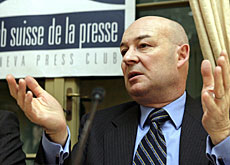
Doubt cast over Guantanamo “suicides”

Swiss forensic pathologists who carried out an autopsy on a Guantanamo inmate say many questions surrounding his death remain unanswered.
The team from Lausanne University said all the available evidence pointed to suicide but they could not be 100 per cent sure because the prison authorities had withheld information and material.
“What I find both disappointing and regrettable is that even though there is a priori no reason to doubt suicide, they have not let us have access to evidence that substantiates this theory,” said forensic pathologist Patrice Mangin.
According to the United States authorities, Yemeni Ahmed Ali Abdullah, who was in his thirties, was found hanged in his cell at Guantanamo Bay on June 10, 2006. Two Saudi inmates reportedly hanged themselves the same night.
The US government sparked a furore at the time of the “suicides” when senior officials described their deaths as an act of war.
Abdullah’s family rejected the initial autopsy carried out at the naval base, saying he would never have taken his own life.
They contacted Geneva-based non-governmental organisation Alkarama for Human Rights which asked Lausanne University’s Institute of Legal Medicine to carry out a second autopsy.
This was performed at a military hospital in Sanaa, the capital of Yemen, on June 21 by a team led by professor Mangin.
Cause of death
Their report, presented in Geneva on Friday, made it clear that suicide was the most likely cause of death. But Mangin said other hypotheses could not be ruled out as body parts were missing and vital pieces of information had not been handed over.
A request was sent to the US army medical authorities asking for a copy of the original autopsy, histological and anatomical samples, and further explanation surrounding Abdullah’s death. But these were not forthcoming.
Pieces of his upper airways including the larynx, hyoid bone and thyroid cartilage – key elements in an autopsy on a hanging victim – were all missing.
Pathologists still don’t know how the body was found, the precise nature of the ligature around Abdullah’s neck and what measures were taken to revive him (there was a puncture mark on the body).
A Saudi forensic pathologist who carried out a second autopsy on the two Saudi inmates is said to have encountered similar problems with the US authorities.
Prisoner resistance
The Yemeni spent four years at Guantanamo where, according to human rights campaigners, he was one of the ringleaders of prisoner resistance, along with the two dead Saudis.
Rachid Mesli, Alkarama’s legal director, said a number of witnesses had dismissed the suicide theory.
He added that a “collective suicide” was unlikely due to a number of reasons – not least because the prisoners were under intense surveillance and that it was practically impossible to attach a cord in one of the cells.
“All these outstanding questions lead us to reject the suicide theory,” he said.
Dan Wendell, spokesman for the US embassy in Bern, insisted that Washington took its responsibilities at Guantanamo very seriously.
“We do everything possible to protect the inmates even from their own attempts to harm themselves,” he told swissinfo.
He added that the bodies of the dead men had been treated humanely and with cultural sensitivity.
swissinfo, Adam Beaumont in Geneva
Alkarama plans to hand over the dossier to the UN special rapporteur on extrajudicial executions and to the UN special rapporteur on human rights and counter-terrorism.
Abdullah’s family also intends to launch legal action in the US in an attempt to get more information released.
The US has been holding people whom it suspects of involvement in terrorism at a detention centre in Guantanamo Bay since 2002.
Up to 400 detainees from more than 30 countries are said to be held there.
The Swiss government and the ICRC have raised concerns about human rights at the camp.

In compliance with the JTI standards
More: SWI swissinfo.ch certified by the Journalism Trust Initiative





























You can find an overview of ongoing debates with our journalists here . Please join us!
If you want to start a conversation about a topic raised in this article or want to report factual errors, email us at english@swissinfo.ch.